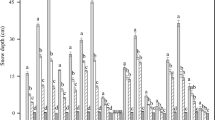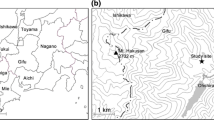Abstract
In order to improve the understanding of the role of a canopy opening/gap on the physical environments in a secondary forest in Northeastern China, a case study was conducted in and around a small irregular gap in a montane secondary forest. The secondary forest, which was severely disturbed by human beings about 50 years ago, was dominated by Quercus mongolica and Fraxinus rhynchophyllaan. Temporal variation in photosynthetic photon flux density (PPFD), air temperature (T A) at 10 cm above the ground, soil temperature (T S) and soil water content (SWC) at top-layer (0–15 cm) and sub-layer (15–30 cm) were measured from May to September after the second year since the formation of the small gap (the ratios of gap diameter to stand height were less than 0.5) in 2006 respectively. Results indicated that the highest value of PPFD occurred at the northern edge of the gap, particularly at the beginning of the growing season in May. On sunny days, the highest value of PPFD appeared earlier than that on overcast days. Maximum and mean values of T A were higher in the northern part of the gap, and the minimum values of T A were at the southern edge of the gap. Soil temperature varied obviously in the gap with the range from 1 to 8 °C. Maximum values of T S occurred at the northern part of the gap, which was significantly correlated with the maximum values of T A (R = 0.735, P<0.05). SWC was higher in the top-layer (0–15 cm) than that in sub-layer (15–30 cm), but the difference of them was not significant (p>0.05), which might be attributed to the small gap size and the effects of aboveground vegetations. From these results, the maximum of PPFD in the study area occurred at the northern part of the gap, which was consistent with the results observed in north hemisphere, but the occurrence time varied with the differences of the latitudes. The highest values of air and soil temperatures also occurred in the northern part of the gap because they were affected by the radiation. However, the variation of temperature in July was different from other months due to the influence of gap size. And the values of soil water content were neither higher in the gap in the wet season nor lower in the dry season, which might be affected by the gap size and topography the gap located. The variations of light, soil and air temperatures, and soil moisture in this small irregular gap might be related to the effects of the micro-site, which affects the regeneration of plant species.
Similar content being viewed by others
References
Blanco, J.A., Imbert, J.B. and Castillo, F.J. 2006. Influence of site characteristics and thinning intensity on litterfall production in two Pinus sylvestris L. forests in the western Pyrenees. Forest Ecology and Management, 237(1–3): 342–352.
Bouchard, M., Kneeshaw, D. and Bergeron, Y. 2005. Mortality and stand renewal patterns following the last spruce budworm outbreak in mixed forests of western Quebec. Forest Ecology and Management, 204(2–3): 297–313.
Catherine, L.C. and Robin, L.C. 2005. Inner-crown microenvironments of two emergent tree species in a lowland wet forest. Biotropica, 37(2): 238–244.
Chapman, R.A., Heitzman, E. and Shelton, M.G.D. 2006. Long-term changes in forest structure and species composition of an upland oak forest in Arkansas. Forest Ecology and Management, 236(1): 85–92.
Chen Xialin. 1999. Structure exploration of forest ecosystem management. Journal of Central South Forestry University, 19(2): 43–46,70. (in Chinese)
Clinton, B.D. 2003. Light, temperature, and soil moisture response to elevation, evergreen understory, and small canopy gaps in the southern Appalachians. Forest Ecology and Management, 186(1–3): 243–255.
Ding Shengyan and Song Yongchang. 2004. Research advances in vegetation dynamic of evergreen broad-leaved forest. Acta Ecological Sinica, 24(8): 1765–1775. (in Chinese)
Gagnon, J.L., Jokela, E.J. and Huber, D.A. 2004. Characteristics of gaps and natural regeneration in mature longleaf pine flatwoods ecosystems. Forest Ecology and Management, 187(2–3): 373–380.
Gálhidy, L., Mihók, B., Hagyó, A., et al. 2006. Effects of gap size and associated changes in light and soil moisture on the understorey vegetation of a Hungarian beech forest. Plant Ecology, 183(1): 133–145.
Gehlhausen, S.M., Schwartz, M.W. and Augspurger, C.K. 2000. Vegetation and microclimatic edge effects in two mixed-mesophytic forest fragments. Vegetatio, 147(1): 21–35.
Gray, A.N. and Spies, T.A. 1997. Micro-site controls on tree seedling establishment in conifer forest canopy gaps. Ecology, 78(8): 2458–2473.
Guo Qingxi, Ge Jianping, Ma Chenghui, et al. 1998. Gap regime and regeneration of Pinus koraiensis in Korean Pine—Mixed Forest at Mt, Changbai. Journal of Northeast Forestry University, 26(1): 4–7. (in Chinese)
Härdtle, W., Oheimb, G. and Westphal, C. 2003. The effects of light and soil conditions on the species richness of the ground vegetation of deciduous forests in northern Germany (Schleswig-Holstein). Forest Ecology and Management, 182(1–3): 327–338.
Heinemann, K and Kitzberger, T. 2006. Effects of position, understory vegetation and coarse woody debris on tree regeneration in two environmentally contrasting forests of north-western Patagonia: a manipulative approach. Journal of Biogeography, 33(8): 1357–1367.
Heithecker, T.D. and Halpern, C.B. 2006. Variation microclimate associated with dispersed-retention harvests in coniferous forests of western Washington. Forest Ecology and Management, 226(1–3): 60–71.
Kariukia, M., Kooyman, R.M., Smith, R.G.B., et al. 2006. Regeneration changes in tree species abundance, diversity and structure in logged and unlogged subtropical rainforest over a 36-year period. Forest Ecology and Management, 236(2–3): 162–176.
Koch, R. and Brang, P. 2005. Microsite patterns of conifer seedling establishment and growth in a mixed stand in the southern Alps. Forest Ecology and Management, 210(1–3): 67–79.
Li Xiaoyan, Liu Lianyou, Gao Shangyu, et al. 2005. Microcatchment water harvesting for growing Tamarix ramosissima in the semiarid loess region of China. Forest Ecology and Management, 214(1–3): 111–117.
Li Zhenghai, Tian Guiquan and Bao Yajing. 1997. Disturbance Theory of Ecology and Its Relative Concepts. Acta Scientiarum Naturalium Universitatis NeiMongol, 28(1): 130–134. (in Chinese)
Liang Xiaodong and Ye Wanhui. 2001. Advances in study on forest gaps. Journal of Tropical and Subtropical Botany, 9(4): 355–364. (in Chinese)
Liu Wenjie, Li Qingjun, Zhang Guangming, et al. 2000. Microclimatic characteristics of canopy gaps in shorea chinensis forest in XiShuangBanNa. Acta Phytoecologica Sinica, 24(3): 356–361. (in Chinese)
McAlpine, K. and Drake, D.R. 2002. The effects of small-scale environmental heterogeneity on seed germination in experimental treefall gaps in New Zealand. Vegetatio, 165(2): 207–215.
McCarthy, J. 2001. Gap dynamics of forest trees: A review with particular attention to boreal forests. Environmental Reviews, 9(1): 1–59.
Poulson, T.L. and Platt, W.J. 1989. Gap light regimes influence canopy tree diversity. Ecology, 70(3): 553–555.
Pritchard, J.M. and Comeau, P.G. 2004. Effects of opening size and stand characteristics on light transmittance and temperature under young trembling aspen stands. Forest Ecology and Management, 200(1–3): 119–128.
Ren Hai, Cai Xi’an, Rao Xingquan, et al. 2001. The theory on succession of plant community. Ecological Science, 20(4): 59–67. (in Chinese)
Ricklefs, R.E. 1977. Environmental heterogeneity and plant species diversity: a hypothesis. American Naturalist, 111: 376–381.
Ritter, E., Dalsgaard, L. and Einhorn, K.S. 2005. Light, temperature and soil moisture regimes following gap formation in a semi-natural beech-dominated forest in Denmark. Forest Ecology and Management, 206(1–3): 15–33.
Runkle, J.R. 1990. Gap dynamics in an Ohio Acer-Fagus forest and speculations on the geography of disturbance. Canadian Journal of Forest Research, 20(5): 632–641.
Schaetzl, R. J., Burns, S. F., Johnson, D. L. et al. 1989. Tree uprooting: review of impacts on forest ecology. Plant Ecology, 79(3): 165–176.
Sha Liqing and Cao Min. 1999. Nutrients in treefall gap of tropical seasonal rainforest in Xishuangbanna. Journal of Northeast Forestry University, 27(6): 78–80. (in Chinese)
Walters, M.B.L., Cleo, C. and Coates, K.D. 2006. Soil resources and the growth and nutrition of tree seedlings near harvest gap — forest edges in interior cedar-hemlock forests of British Columbia. Canadian Journal of Forest Research, 36(1): 62–76.
Wang Jinshu, Wang Yanmei, Chen Liang, et al. 2002. The pilot study on the heat transferring between different media in tropical secondary forest gap of Xishuangbanna. Journal of Xuzhou Normal University (Natural Sciences), 20(3): 71–74. (in Chinese)
Wang Jiahua and Li Jiandong. 2006. Advances in study on forest gaps. World Forest Research, 19(1): 27–30. (in Chinese)
Wang Jinxin and Zhang Yiping. 2002. A Review on within gap microenvironmental heterogeneity and species response. Journal of Nanjing Forestry University (Natural Sciences Edition), 26(1): 59–64. (in Chinese)
Wang Jinxin, Zhang Yiping, Ma Youxin, et al. 2000. Linear character of the sunshine of the gap in the artifical forest in Xishuangbanna. Journal of Plant Resources and Environment, 9(1): 27–30. (in Chinese)
Xia Bing, Deng Fei and He Shanan. 1997. Advances on the forest gap studies. Journal of Plant Resources and Environment, 6(4): 50–57. (in Chinese)
Xiang Yanci, Peng Shaolin, Zhou Houcheng, et al. 2002. The influences of gaps in different forest communities on the growth of seedling of three transplanted tree species in Nan’ao Land, Guangdong. Acta Phytoecologica Sinica, 26(2): 230–234. (in Chinese)
Zang Runguo and Xu Huacheng. 1998. Advances in forest gap disturbance research. Scientia Silvae Sinincae, 34(1): 90–98. (in Chinese)
Zhang Yiping, Dou Junxia, Ma Youxin, et al. 2003. Temporal-spatial distribution characteristics of microclimate in tropical secondary forest canopy gap in Xishuangbanna. Chinese Journal of Applied Ecology, 14(12): 2129–2135. (in Chinese)
Zhang Yiping, Ma Youxin, Liu Yuhong, et al. 2001. Characteristics of spatial distribution of microclimatein the gap of ever-green broad-leaved forest in the north of Ailao mountain in Yunnan. Journal of Beijing Forestry University, 23(4): 80–83. (in Chinese)
Zhang Yiping, Wang Jinxin, Liu Yuhong, et al. 2001. Study on the sun-shine characteristics of the tropical secondary forest gap in the dry-hot season in Xishuangbanna. Guihaia, 21(1): 1–8. (in Chinese)
Zhu, J. J., Matsuzaki, T., Li, F. Q. et al. 2003. Effect of gap size created by thinning on seedling emergency, survival and establishment in a coastal pine forest. Forest Ecology and Management, 182(1–3): 339–354.
Zhu, J. J., Li, X.F., Liu, Z.G, et al. 2006. Factors affecting the snow/wind induced damage of a montane secondary forest in northeastern China. Silva Fennica, 40(1): 37–51.
Author information
Authors and Affiliations
Corresponding author
Additional information
Foundation project: This research was supported by National Natural Science Foundation of China (30671669) and “the 100-Young-Researcher Project” of Chinese Academy of Sciences.
Biography: ZHU Jiao-jun (1965–), male, Professor in Institute of Applied Ecology, Chinese Academy of Sciences.
Rights and permissions
About this article
Cite this article
Zhu, Jj., Tan, H., Li, Fq. et al. Microclimate regimes following gap formation in a montane secondary forest of eastern Liaoning Province, China. J. of For. Res. 18, 167–173 (2007). https://doi.org/10.1007/s11676-007-0035-7
Received:
Accepted:
Issue Date:
DOI: https://doi.org/10.1007/s11676-007-0035-7




